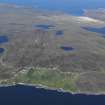Polbain
Cruck Framed Building (Period Unassigned), Lazy Beds (Period Unassigned), Stack Stand (Period Unassigned), Township (19th Century)
Site Name Polbain
Classification Cruck Framed Building (Period Unassigned), Lazy Beds (Period Unassigned), Stack Stand (Period Unassigned), Township (19th Century)
Canmore ID 114811
Site Number NB91SE 24
NGR NB 9941 1001
NGR Description Centred NB 9941 1001
Datum OSGB36 - NGR
Permalink http://canmore.org.uk/site/114811
- Council Highland
- Parish Lochbroom
- Former Region Highland
- Former District Ross And Cromarty
- Former County Ross And Cromarty
Field Visit (23 June 1994)
NB91SE 24 centred 9941 1001
The crofting township of Polbain developed in the 19th century on land which had previously been part of the farm of Dornie whose land was mapped by May in 1758 (SRO, RHP 85395). The 1st edition of the OS 6-inch map (Cromartyshire 1881, sheet iiia) depicts about twenty-five buildings, mostly along the NE edge of the township, above the line of the present road. Most of the buildings are depicted with an enclosed allotment, but much of the improved ground appears to be undivided. By the time of the 2nd edition of the map (Ross and Cromarty 1906, sheet iiia) the road had been established on its present line, there had been some expansion of the township at its E end and some of the buildings shown on the previous map had been replaced, but there seems to have been little further subdivision of the improved ground between the two editions.
Many of the croft houses depicted on the early OS maps have been replaced, but some early buildings survive, often used as outhouses. Eight roofless structures were recorded. One of these, a building which does not appear on either of the first two editions of the OS map and is cut by the boundary between two crofts, may predate the establishment of the township. It is situated above the shore towards the SW corner of the settlement at NB 9941 1001 and it measures 10.4m NE-SW by 3.6m transversely over faced-rubble walls 0.7m thick. It is divided into two compartments and there is an entrance in the SE side (ACHIL94 276).
At the W edge of the township, just below the junction of the roads from Dornie and Altandhu, there are the fragmentary remains of a building, largely obscured by bracken when visited, which is shown roofed on the 2nd edition map. A hut, also ruinous, stands within its W corner (ACHIL94 277, NB 9934 1020). About 15m to the SE there is a hut, also roofed on the 2nd edition map, which measures 4.8m in length by 2.7m in breadth within faced-rubble walls standing 0.7m high (ACHIL94 278). A wooden shed now stands within it.
In heather-covered ground just beyond the NE edge of the township at NB 9970 1023 there are the remains of a rectangular hut which measures internally 3.1m E-W by 2.5m (ACHIL94 279). This hut is also shown, roofed, on the 2nd edition map.
The other four structures recorded are all at the SE edge of the township. The largest of these is a rectangular two-compartment building which measures 10.2m from NNW to SSE by 4m transversely within faced-rubble walls which stand up to 1.7m high (ACHIL94 274, NB 9993 0976). A pair of cruck slots survive in the NNW compartment and another slot is visible in the SSE compartment. An outshot extends 3.1m to the SSE and there is an enclosure to the WSW. About 90m to the SSE there is another building, aligned NW-SE and measuring 5.6m in length by 3.6m in breadth within walls up to 1.2m high (ACHIL94 275). It has an outshot on the SE and there is a small enclosure to the SW. Both of these buildings are shown roofed on the 1st edition map, but the latter, and the NNW compartment of the former, were roofless by the time of the 2nd edition. Midway between them there are the stone footings of two small huts, measuring internally 2.8m by 2.5m (ACHIL94 272) and 3m by 1.3m (ACHIL94 273).
Within the crofts there are occasional remnants of lazy-beds, and at NB 9965 0993 there is a solitary stack stand.
(ACHIL94 272-9)
Visited by RCAHMS (SDB), 23 June 1994.
Field Visit (1996)
Sites recorded during a survey of the intertidal zone and the coast edge (50m from the mean high tide mark) between the Rivers Ullapool and Culag.
Further details can be found in a report submitted to Historic Scotland.
NB 997 096 Rectilinear structures.
NB 995 097 Rectilinear kelp kiln.
Sponsors: Historic Scotland, Glasgow University Archaeology Department.
A Long 1996.






















































